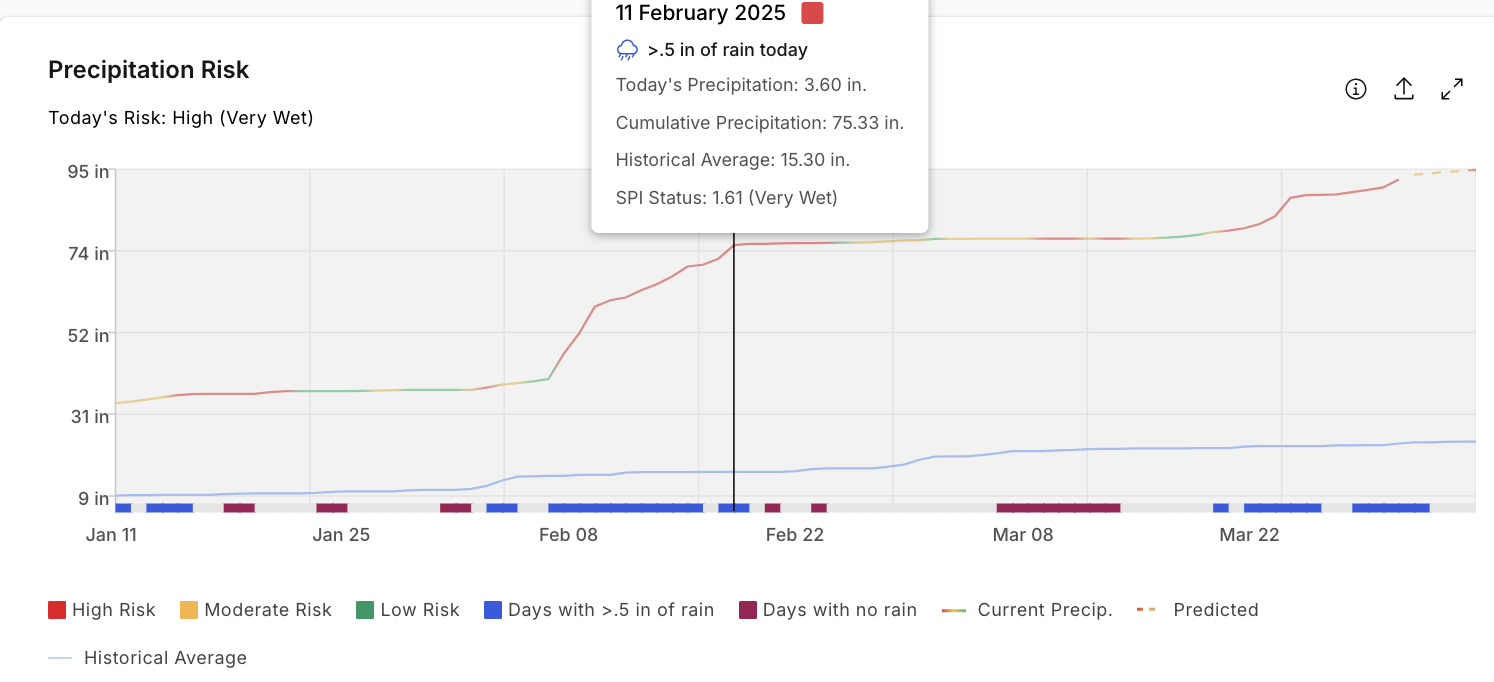A Wall of Water: How Cyclone Alfred Devastated Queensland’s Sugarcane Heartland
In February through early March 2025, Tropical Cyclone Alfred delivered destructive winds and unprecedented rainfall to Far North Queensland, devastating the region’s sugarcane industry. Over this period, the cyclone system and associated storm activity brought between 16 to 26 inches within just 48 hours, with some localized areas around Tully and Ingham recording over 28 inches of precipitation (FreshPlaza). This rapid and sustained accumulation of rainfall caused major river overflows, breached levees, and submerged low-lying agricultural land—impacting some of Australia’s most critical cane-producing regions.
The Helios dashboard shows an exceptionally wet season, with total precipitation reaching 62.28 inches—162.2% above normal—and 38.53 inches more than the historical average; the region also experienced 61% fewer dry days and 147% more days with over half an inch of rain, highlighting the extreme rainfall and flood conditions triggered by Cyclone Alfred.
Growers in districts like the Herbert, Tully, and Burdekin reported severe crop loss, soil erosion, and extensive damage to field infrastructure. “It was a wall of water. You could hear it before you saw it,” said one grower from Innisfail, reflecting on the speed and force of the flooding. Mature sugarcane ready for harvest was flattened or left submerged for days—conditions that drastically reduce sugar content and increase disease risk. According to ABC Rural, the damage to transport tramlines and processing infrastructure has prompted sugar mills in Tully and Ingham to delay operations and reassess their capacity for the season.
This chart illustrates that from January through March 2025, the majority of agricultural risk days were driven by excess moisture, with sharp spikes in “too wet” January throughout early March, coinciding with Cyclone Alfred’s peak impact and its aftermath on Queensland’s cropping systems.
The cyclone’s impact extended beyond field-level damage. Queensland is responsible for approximately 60% of Australia’s total sugarcane production, and the disruption to harvesting, processing, and logistics had immediate consequences for both domestic and export markets. A March 2025 supply chain analysis found that sugarcane and banana exports fell by 25% in the weeks following the event, largely due to blocked transport routes and flooded infrastructure. With more than 20,000 hectares of farmland affected across multiple crops, sugarcane growers now face both production shortfalls and rising costs associated with recovery and replanting.
While bananas, lettuce, and other fresh produce have garnered national attention, the longer-term impact on sugarcane may be even more consequential for the agricultural economy. As growers, supply chains, and local governments begin recovery efforts, there is growing consensus on the need for long-term investment in flood resilience, climate-adapted crop systems, and improved forecasting tools. During and after Cyclone Alfred, the Helios platform provided real-time monitoring of rainfall intensity, field-level flooding, and operational disruptions—offering valuable insights to growers, agribusinesses, and response teams. As the region recovers, these tools will be critical to building a more resilient future for one of Queensland’s most vital agricultural industries.


